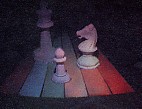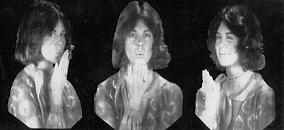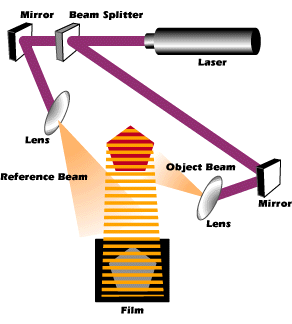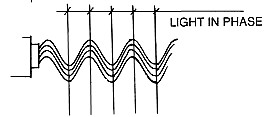Holography is a three-dimensional
imaging technique. It uses laser light to record the patterns of
light waves reflected from an object onto the emulsion of light
sensitive film (or glass plates). When that film is developed, and
re-exposed to laser light (or normal incandescent light like most
holograms today), it re-creates -- in space -- all the points of
light that originally came from the object. The resulting image,
either behind or in front of the holographic film, has all the
dimensions of the original object and looks so real that you are
tempted to reach out and touch it -- only to find nothing there
but focused light.
Unlike photography or painting, holography can render a subject
with complete dimensional fidelity. A hologram creates everything
your eyes see -- depth, size, shape, texture, and relative
position – from many points of view. In fact, the term "hologram"
was coined from the Greek words holos, meaning "whole," and
gramma, meaning "message."

More than one 3-dimensional image can be recorded on the same
piece of film. For example, the two-channel hologram,
"Brain/Skull" (produced by The Polaroid Corporation in 1982),
displays two different images as it is viewed from left to
right.
There are two basic types of holograms -- reflection and
transmission. They can be distinguished by the way in which they
are illuminated.
Reflection holograms are lit from the front,
reflecting the light to you as you view it, like a painting or
photograph hung on a wall. Different film emulsions produce images
with different characteristics.
1. Silver Halide is the emulsion of choice for most
artists and holographers who use silver halide glass plates to
achieve the highest quality images. Holographers also use silver
halide film, which is cheaper, less fragile and easier to handle
but does not produce the depth, resolution and projection possible
with glass plates. However, film is used successfully for longer
production runs.
2. Dichromated Gelatin (DCG) is a chemical-gelatin mix
that is coated onto a piece of glass. Dichromates produce very
bright images in a golden-yellow color. The images have the least
range of depth, but they are viewable in normal room light without
special spotlights. This makes Dichromates suitable as small gift
products for the consumer gift market or the premium &
incentive industry. Dichromates have largely been replaced with
cheaper mass produced photo polymer holograms. The medium still
works best for high performance diffractive optics and probably
will for a long time to come. Bright, clean DCG masters are still
made for copying into photo polymers.

From 1975 - 1984, Rich
Rallison (International Dichromate Corp., Draper, UT) pioneered the
production of glass sandwich dichromate holograms that were used
as jewelry pendants, key chains, paper weights, and other premium
items. He produced these various sized dichromates (up to 3") with
Jason Sapan, Holographic Studios, NYC in 1978-79.
3. Photo polymer is the newest of the recording
materials. Developed by Polaroid and Dupont, photo polymers have a
plastic backing and are suitable for long production runs. The
image depth of photo polymers is slightly less than that of silver
halide; however, the images are brighter, with a wider angle of
view.
Transmission holograms are lit from the rear
(like a photographic transparency) and bend light as it passes
through the hologram to your eyes to form the image.
1. Laser transmission holograms are made with lasers,
like all holograms, but also must be lit with lasers to be viewed.
Therefore, the images appear in the color of the laser used in
illuminating them for viewing, usually red (helium neon laser).
Other types of holograms use a laser transmission hologram as the
master, from which copies are made. This is the earliest type of
hologram developed by Leith and Upatniks in 1962.
2. White light transmission holograms are illuminated
with incandescent light (white light) and produce images that
contain the rainbow spectrum of colors. The colors change as the
viewer moves up and down and are often called "rainbow" holograms.
Holographers have developed considerable control over the colors
displayed in this type hologram to produce images in a specific
color or in near full, natural color.

This is the
first full color hologram, a 4 x 5" full color one step white
light transmission hologram by Dr. Stephen A. Benton, Herbert
Mingace, Jr. and William R. Walter, The Polaroid Corporation, in
1979.(Photo by S.A. Benton, Collection of MIT Museum, Cambridge,
MA)
Other techniques have been developed to record living subjects,
to show movement and to extend the mass-production capabilities of
the medium.
Pulsed holography uses a quick, intense burst of laser
light to record the subject in few nanoseconds – too quick for
movement to be a factor. This is similar to strobe or flash
photography and has been used extensively for portraitures.
Integral holography, developed by Lloyd Cross, combines
holography with cinematography to record a stereogram as a
white-light transmission hologram. Several frames of 2-D motion
picture footage are converted frame-by-frame to narrow, slit
holograms stacked side-by-side on a piece of holographic film.
Early integrals were mounted in a circular or semi-circular format
and produced an image that appeared in the center with several
seconds of movement. Any subject that can be recorded or
reproduced as movie footage, video or computer graphics can be
made into a holographic image.

This is a series of photographs
taken of "Kiss II" (1974), an integral hologram produced by Lloyd
Cross, inventor of the process. The hologram -- which was made
from approximately 360 frames of motion picture footage -- was
typically mounted in a semi-circular, wall-mounted display and
illuminated by a single light bulb below. The floating,
3-dimensional image of Pam Brazier blows a kiss and winks as the
viewer walks by. (Photo by Daniel Quat, 1977)
Embossed holograms are transmission holograms with a
mirror backing that are applied to magazines, promotional items and
credit cards. Embossing is the most frequently used method of
mass-production in holography. The holographic information is
transferred from light sensitive glass plates to nickel embossing
shims. The holographic images are "printed" by stamping the interference
pattern onto plastic and then backing the images with a light
reflecting foil. The resulting hologram can be duplicated millions
of times for a few cents apiece.
How a Hologram Is
made
The diagram below illustrates a typical
holographic layout on a vibration-free table top in a completely
darkened room. The exposure must be made in an environment void of
any movement or vibration. Even movement to the degree of half a
wave length of light will prevent the recording of the image on
the film.

A beam of laser light is optically separated into two
beams. One, the reference beam, is directed toward a piece of
holographic film and expanded (its diameter increased) so that the
light covers the film evenly and completely. The second (object)
beam is directed at the subject of the composition and similarly
expanded to illuminate it.
When the object beam reflects off the subject, it carries with
it information about the location, size, shape and texture of the
subject. Some of this reflected object beam then meets the
reference beam at the holographic film, producing an interference
pattern which is recorded in the light sensitive emulsion.
Holographers use basically the same kinds of film and developers
as photographers. The standard silver-halide film (or glass plate) is
similar to its photographic counterpart; but it is slower and requires longer
exposure times, has a finer resolution, and is more sensitive to red light.
Processing involves the same developer, hypo and fixer used in photography.
Bleaches are used to brighten the image, and more exotic chemicals are used
occasionally to shrink or swell the emulsion to control the image color.
After the film is developed, the hologram is illuminated at the
same angle as the "reference" beam during the original exposure to
reveal the 3-D image.
A hologram must be illuminated to produce the image. Although
laser light is used to make holograms, holograms are usually
illuminated with normal incandescent spotlights.
To see a holographic image, the viewer must look at the film. "Projected"
images appear in the space between the film and the viewer.
There is no current technology that gives the ability to project an
aerial or focused image into open space without interposing some type of
screen such as smoke, mist, film or a concave mirror. Images
cannot be projected from the film to a distant point. A Hologram can produce
a real or virtual image in space, but only when it is viewed through or reflected
from the physical film.
The projected image of Princess Leia from the chrome-dome of R2D2 in
the 1977 movie Star Wars was a Cinematographic special effect – not
holography. Perhaps holography will make this a reality in the
future.
Attention students and educators:
You can learn to make holograms and teach holography by visitng
Integraf L.L.C., a one-stop resource for holographic film & plates, holography kits, holograms, books and instructional materials.
Integraf has also produced a superb. free article, "Simple Holography, The Easiest Way to Make Holograms", that offers instructions for first-time holographers, such as students, teachers, and hobbyists with a smaller budget.
.
Glossary of Terms
Amplitude - The height of a wave crest or depth of a wave trough,
measured from the wave's mid-point.

Beamsplitter - A device used to divide the light from the laser into
two separate beams - the reference and object beams. It consists of a
partially transparent mirror which reflects part of the laser beam and
transmits the rest.
Coherent light - Light which is of the same frequency and is
vibrating in phase. The laser produces coherent light.


Film - Whether photographic or holographic, film consists of
light sensitive chemicals (the emulsion) spread on a surface. A film's
resolution measures its ability to distinguish between details.
Because holographic films must be able to record very detailed information,
they have a resolving power of 50 or more times that of photographic film.
They require either exposure to a high intensity pulsed or a long exposure
to a continuous wave laser. Holographic film is developed in a manner similar
to photographic film, by bathing it in a series of chemical agents.
Hologram - A medium for bending and focusing light. It uses the
interference of monochromatic object and reference waves to record and reproduce
multiple 2-D images for a 2-D view. Unlike photography, which records an
image as seen from a single view point, a hologram is a record of an image as
seen from very many viewpoints.
Holographic stereogram - Made by converting conventional movie frames
into holograms, displayed in a cylinder or as a flat picture. The viewer sees two
separate images at a time, for an illusion of depth and motion.
Interference pattern - When two waves overlap, their amplitudes add at
every point. This results in an interference pattern which records the relative phase
relationships between the two waves, storing each individual wave's characteristics.
This is how a hologram works.
Laser - An acronym for "Light Amplification by Stimulated Emission of
Radiation." A laser is a device that produces a concentrated beam of coherent light.
Some, called continuous wave lasers, produce a continuous beam of light.
Others, called pulsed lasers, emit more light in brief pulses which are able to
freeze motion.
Lenses - Lenses are devices which redirect light. In photography, lenses
are used to focus an image for the film. Holographers use lenses to widen the
lasers beam to illuminate all of the subject which is to be holographed.
Object beam - The light from the laser beam that illuminates the
object, and is reflected to the holographic film.
Phase - The position of a wave in space, measured at a particular point
in time.

Reference beam - The portion of the laser beam that goes directly to
the holographic film. The interference pattern which results from the object
beam meeting the reference beam at the holographic film is recorded on the film.
Reflection hologram - One that forms an image by reflected light.
Reflection holograms are lit from the front, reflecting the light to the viewer.
Transmission hologram - One that forms an image from the light passing
through the holographic emulsion. Transmission holograms are lit from the rear,
bending the light as it passes through the hologram to your eyes.
White light - Light which contains most of the wavelengths in the visible
spectrum, such as light from the sun or a spotlight. White light is incoherent,
while laser light is coherent. A white light transmission hologram (or rainbow
hologram) is one which can be displayed using ordinary white light. Early
holograms required viewing with coherent laser light.
The Guide to Practical
Holography, by Chris Outwater and Van Hamersveld is an
excellent book for the beginner. It's illustrated and free on
line.
 Home | Background | Clients | Spectral Imagery
Home | Background | Clients | Spectral Imagery
Holograms | Exhibitions | Media Comments
About Holography | History | E-mail
© 1995-2011 Holophile, Inc.









